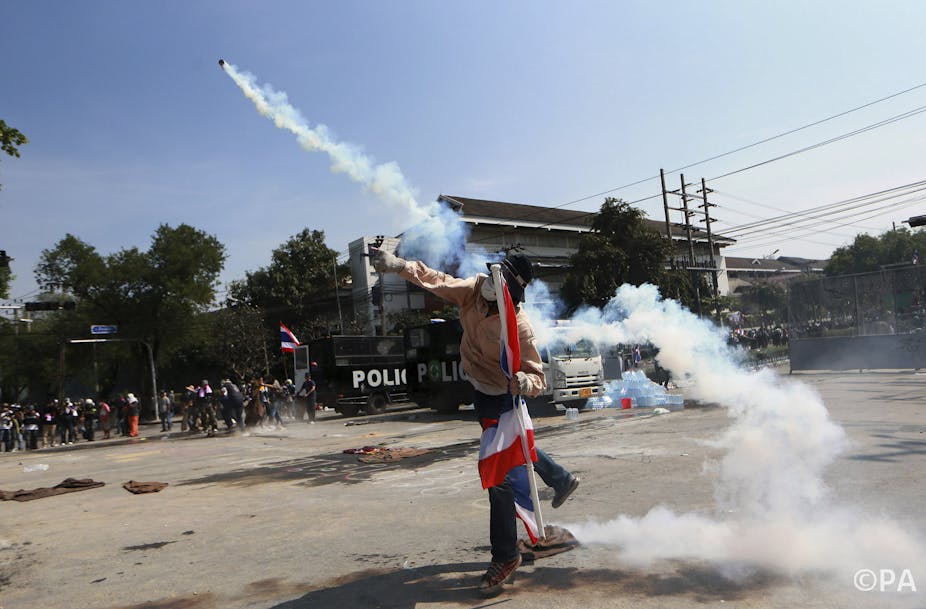There has been much coverage of Thailand’s protests, with stories of the Yellow Shirt (PAD) and Red Shirt (UDD) saga popping up around the globe. Yet there is a conspicuous lack of discussion about what is next for Thailand. If the country is to realise its goal of becoming Southeast Asia’s logistical hub, it must first overcome its deeply rooted political instability.
Understanding that instability requires a basic explanation of the Thai social environment. As in any given state, geographical variation and societal cleavages within and across communities matter. While geography sheds light on the interplay between instability and stability, demographics help to explain why the present protests in Thailand are contained, and unrest is in fact relatively limited.
The Thai state is maintained by an administrative provincial system: the country is divided into 76 provinces, with each one responsible for providing services and allocating resources downward to municipalities and districts. This system is overseen by the Interior Ministry, the key actor for ensuring security and maintaining stability across the regions.
The administrative provinces are gathered into northern, northeast, southern, eastern, western and central regions. Some 40% of the total population lives in the northeast region; only 12.6% of the population lives in Bangkok, which is a separate administrative area from the other 76 provinces.
The geographical distribution of the Thai population is reflected in the makeup of both the pro- and anti-government networks. Support for the anti-government side is concentrated in the southern region and Bangkok, while the pro-government base is in the northern, northeastern and central regions. Within Bangkok itself, the government has the support of the urban working classes, while the anti-government movement is primarily from the more prosperous middle classes of the capital, its surrounding area, and the southern region.
The struggle over ‘Thaksinism’

Thailand has multiple political parties, which are lumped into two main networks: the Red Shirts and the Yellow Shirts. The Red Shirts comprise a coalition of actors within the United Front for Democracy against Dictatorship (UDD), and provide most of the support for the governing Pheu Thai Party (PTP).
The PTP has many links with the old Thaksin Shinawatra government that fell in 2006-7. Most obviously, it is the party of Thaksin’s sister Yingluck, the country’s current prime minister. But the links to the old regime go deeper than her. Many of the PTP’s older members hail from the exiled Thaksin’s Thai Rak Thai (TRT) party, which was disbanded for corruption among its governing body – though many of the individuals accused have since been legally cleared. The continued presence of these people at the top level of Thai politics is at the core of what many call “Thaksinism”.
For government supporters, “Thaksinism” denotes a common populist political agenda of crime, drug and poverty reduction, universal healthcare and education, and microcredit economic policies. It is an agenda that is geographically and electorally supported by the majority of Thais.
However, for those opposing the government, “Thaksinism” has become a byword for corruption among the PTP and the political class by the present anti-government protesters. As highlighted by Thailand’s dismal) and sinking ranking on Transparency International’s Corruption Index, corruption is embedded in the Thai system, and is not confined to one person or party. Yet Thaksin’s unique status in the country’s politics has made him the emblem of state corruption for the opposition movement – something not helped by the PTP’s effort to overturn his corruption conviction.
The anti-government camp comprises the People’s Alliance for Democracy (PAD), also known as the Yellow Shirts. Their political base is middle-class, pro-market, liberal-oriented and conservative. Some within the PAD network have spent a portion of their political career opposing “Thaksinism” – which, interestingly, has had the effect of perpetuating Thaksin’s personal myth. The PAD also opposes all attempts of constitutional reform, such as the recent PTP draft law which sought to make parliament a fully elected body.
The UDD and PAD’s rivalry stretches back as far as the 2006 unrest; the present protests are just another round in the Red and Yellow Shirt saga. Ultimately neglected in the saga is the wider Thai population and their needs. Finding and focusing on the issues that unite them is key.
Common ground
Cutting across the existing social, political and geographical cleavages are a set of common grievances. These include disaster and flood management, sustainable economic, housing, human and infrastructural development, and a lack of strategic urban and rural planning. All of them taken together pave the pathway to stability.
Disaster management is another critical issue, especially given recurring floods, poor infrastructural development, and a lack of strategic urban and rural planning. While infrastructure development projects are underway and more are planned, the developmental imbalance remains without strategic urban and rural planning. Strengthening the administrative provincial system will help to facilitate better strategic planning, while the government and society work on corruption and other related issues.
But underlying all the issues is corruption. Thailand has attempted to address its endemic corruption through both bottom-up and top-down initiatives; however, a lack of sustained campaigns has severely limited anti-corruption policies.
These interconnected concerns make for a fraught picture of a frustrated country, but they also offer a platform for potential change. Faulting one person or party and squabbling over whose vision is better will simply entrench divisions, while delaying change and reform. Until the pressing concerns of the overwhelming majority of Thais are assembled into a workable agenda by a government with popular support, any hope of a better future will continue to be thwarted.

